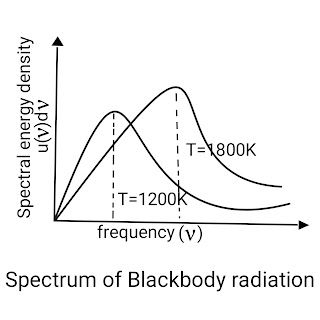Blackbody radiation
2. The spectral energy of a Blackbody depends only on temperature. This relation was given by Stefan and Boltzmann known as Stefan's Boltzmann law as
E 𝛂 T⁴
- The body which absorbs all the radiation falling on it irrespective of frequencies is called a Blackbody.
- The most important part of a Blackbody are its properties.
- Blackbody radiates more radiation when it is hot than when it is cold.
- The spectrum of a Blackbody is given below

Spectrum of Blackbody radiation. - From the spectrum of Blackbody radiation the following observations are made:
2. The spectral energy of a Blackbody depends only on temperature. This relation was given by Stefan and Boltzmann known as Stefan's Boltzmann law as
E 𝛂 T⁴
E = 𝝈T⁴
3. The spectral energy density increase with increase in frequency but for higher frequencies it decreases.
4. A relation between temperature and frequency of a Blackbody was given by Wein's law i.e
λₘT=hc=2.898 × 10⁻³mK.
Questions on Blackbody radiation;
Q1) What do you mean by Blackbody radiation?
Ans) The body which absorbs all the radiation falling on it irrespective of frequencies is called a Blackbody radiation.
Q2) State Stefan's Boltzmann law?
Ans) The spectral energy of a Blackbody depends only on temperature. This relation was given by Stefan and Boltzmann known as Stefan's Boltzmann law as
E 𝛂 T⁴
E = 𝝈T⁴
Q3) State Wein's law?
Ans) A relation between temperature and frequency of a Blackbody was given by Wein's law i.e
λₘT=hc=2.898 × 10⁻³mK.
Q4) What observations are made from spectrum of Blackbody radiation?
Ans) From the spectrum of Blackbody radiation the following observations are made;
1. With the increase in temperature Blackbody radiates more and more energy.
2. The spectral energy of a Blackbody depends only on temperature. This relation was given by Stefan and Boltzmann known as Stefan's Boltzmann law as
E 𝛂 T⁴
2. The spectral energy of a Blackbody depends only on temperature. This relation was given by Stefan and Boltzmann known as Stefan's Boltzmann law as
E 𝛂 T⁴
E = 𝝈T⁴
3. The spectral energy density increase with increase in frequency but for higher frequencies it decreases.
4. A relation between temperature and frequency of a Blackbody was given by Wein's law i.e
λₘT=hc=2.898 × 10⁻³mK.
Comments
Post a Comment